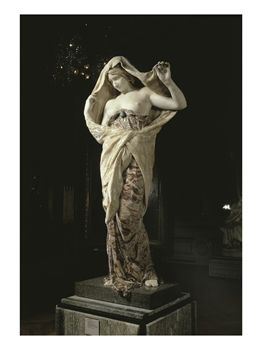 Today, I glanced through the works of Louis-Ernest Barrias (1841-1905), a French Academic and Art Nouveau sculptor. Although his style and training were Academic, it was his subject matter which broke him from Academic norms -- and in a fascinating way.
Today, I glanced through the works of Louis-Ernest Barrias (1841-1905), a French Academic and Art Nouveau sculptor. Although his style and training were Academic, it was his subject matter which broke him from Academic norms -- and in a fascinating way.Art Nouveau was a profoundly optimistic movement. It expressed hope and anticipation for the future of the 20th Century. You can see this vividly in three of Barrias' works in particular.
Nature Unveiling Herself Before Science (1889) at the Musee D'Orsay.
 Electricity, which was at the entrance to the Gallery of Machines at the 1889 Paris Exposition. I don't know where it is now.
Electricity, which was at the entrance to the Gallery of Machines at the 1889 Paris Exposition. I don't know where it is now. Nubian Alligator Hunters (1894), at the Musee D'Orsay.
Nubian Alligator Hunters (1894), at the Musee D'Orsay.Academic art derives directly from Renaissance Humanism, and much of Neoclassicism can taken from the Enlightenment (hence the precipitous decline in religious subject matter in the 19th Century). This central thread of Academic art, then, could be said as culminating in Barrias. Just as the Greeks and the Neoclassicals personified concepts (such as Wisdom, Liberty or Victory) as divine personages, so Barrias created idols to the gods of the new 20th Century religion -- Science. The old gods of religion are dead, hail the new gods (middle) of the scientific method! There are no more mysteries, but only a natural world to be fully exposed (top) and subdued (bottom).
As a recovering humanist (five years clean and sober!), I find this fascinating.
UPDATE: Two content changes made to clarify a couple of points.

No comments:
Post a Comment